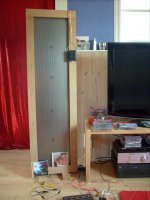There are two well-known advantages of multi-layer ESLs: lower mechanical resonance due to higher weight of coupled diaphragms leading to better deep bass recponce, and higher sensitivity, though it comes from higher capacitance.
Heavy coupled diaphragm also reduces air damping factor, and higher pressure generated by electrical fields compensates higher diaphragm mass. This, I think, is what attributes to better transients (as heard by some) of multi-layer ESLs compared to ordinary ones. Some people also say that ESLs(ordinary) blur peaks of signals and do not sound as emotional on these moments as dynamic drivers.
The known disadvantage is that on higher frequencies, phase lag is present between front and rear diaphragms due to limited speed of sound. Systems wigh many layers and high diaphragm-diaphragm distances are unable to reproduce highs therefore.
I'd like to know though, how this effect is heard in less borderline conditions? For example, two diaphragms, D-D distance of 2.5 mm, hence phase lag at 20 kHz is ~55 degrees. High enough to greatly distort waveform on 'scope, but how would our ears percieve that?
What other disadvantages the multi-layer ESLs have?
Heavy coupled diaphragm also reduces air damping factor, and higher pressure generated by electrical fields compensates higher diaphragm mass. This, I think, is what attributes to better transients (as heard by some) of multi-layer ESLs compared to ordinary ones. Some people also say that ESLs(ordinary) blur peaks of signals and do not sound as emotional on these moments as dynamic drivers.
The known disadvantage is that on higher frequencies, phase lag is present between front and rear diaphragms due to limited speed of sound. Systems wigh many layers and high diaphragm-diaphragm distances are unable to reproduce highs therefore.
I'd like to know though, how this effect is heard in less borderline conditions? For example, two diaphragms, D-D distance of 2.5 mm, hence phase lag at 20 kHz is ~55 degrees. High enough to greatly distort waveform on 'scope, but how would our ears percieve that?
What other disadvantages the multi-layer ESLs have?
I've built a few ESL:s with double isobaric membranes in the bass and a single one for the midrange and highs. I was inspired by an article in a now deceased American HiFi magazine called "Audio". Listen to a pair of M-L CLX and you will understand the advantages of double bass membranes...
JonasKarud,
Thanks! I've read that you have also made dual-diaphragm headphones, since they're supposedly fullrange, I'd like to know if you have found some problems on highs compared to single-diaphragm design?
On second thought, phase difference due to different distances from ear to different driver regions would be way higher than difference from inter-diaphragm distance. Though, that difference increases gradually from zero, while second diaphragm is always there. Hmm...
Thanks! I've read that you have also made dual-diaphragm headphones, since they're supposedly fullrange, I'd like to know if you have found some problems on highs compared to single-diaphragm design?
On second thought, phase difference due to different distances from ear to different driver regions would be way higher than difference from inter-diaphragm distance. Though, that difference increases gradually from zero, while second diaphragm is always there. Hmm...
I enclose a picture of an early prototype of an "ISO-ELS"...
By feeding the signal current to the furthest back stator through a 68K resistor, the isobaric function was limited to the bass region, where it was needed most..
The Neo tweeter was there just for comparison.
By feeding the signal current to the furthest back stator through a 68K resistor, the isobaric function was limited to the bass region, where it was needed most..
The Neo tweeter was there just for comparison.
Attachments
- Status
- This old topic is closed. If you want to reopen this topic, contact a moderator using the "Report Post" button.
- Home
- Loudspeakers
- Planars & Exotics
- Advantages and disadvantages of multi-layer ESL?
